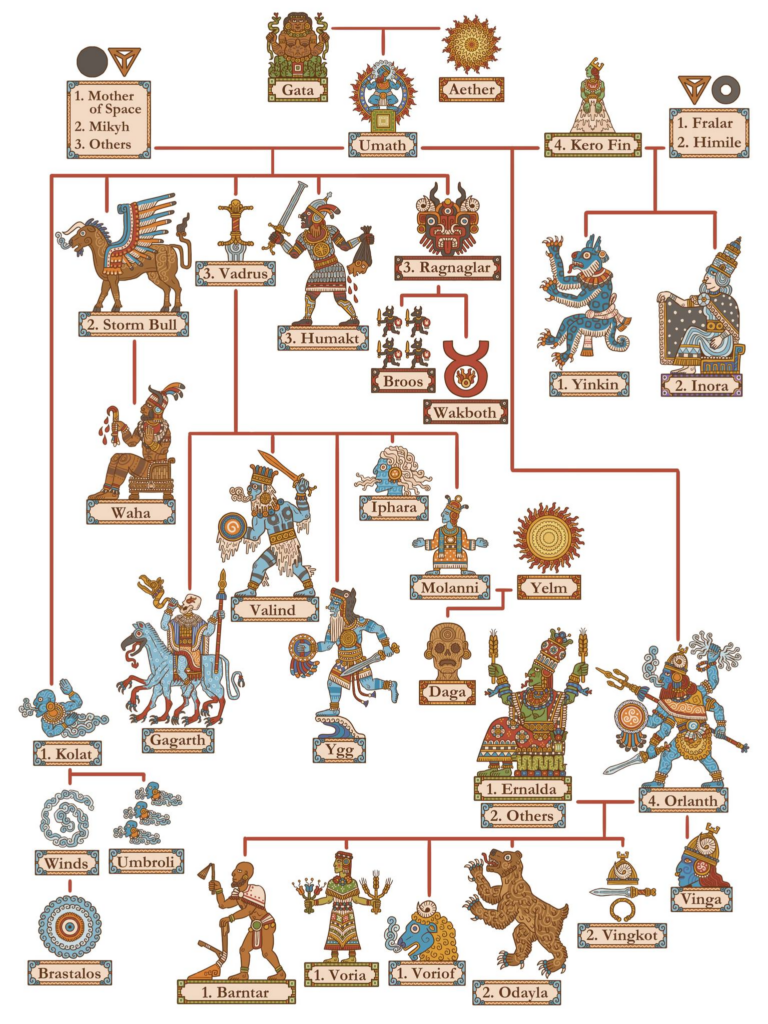Any time you look at those big abstract Celestial Court “deities” they include potential devolutions. So Umath is generally thought to have been “succeeded” by his children – Kolat, Vadrus, Storm Bull, Ragnaglar, Molanni, Humakt, Orlanth, and maybe a few others. Another way of looking at it is that he was “shattered” into these deities and that all of them were inherent within “Umath”.
All of these were “Air Rune gods,” at least initially. Humakt shows an interesting tie between Air and Death that is apparent whenever you get stuck outside in a really bad storm in much of the US.
Most of these Air Rune gods are violent and destructive, but again that goes with the storm god territory. Vadrus was uncontrolled, raw strength, did whatever the hell he wanted (and what he wanted was usually to go wherever his winds carried him and smash up something). He never acknowledged any superior power and never worried about the consequences of his actions. Eventually his brother Orlanth beat him back from the places Orlanth ruled but Vadrus just blew to the north and claimed it for himself. He’d sometimes blow down and beat on other gods elsewhere – if they were under Orlanth’s protection, then Orlanth would beat back Vadrus, otherwise those gods were on their own. Sometimes Orlanth would get Vadrus to fight alongside Orlanth against mutual enemies, but immediately then Vadrus would return to his ways.
Now this sort of conflict is inherent in the Air Rune. Winds don’t blow in consistent directions or speeds. Storms come and go. The only unifying figure between all the Air Rune gods is Orlanth, and that’s basically because Orlanth by hook or by crook got each of the Air gods to submit to him at one time or another (and he never had to submit to them). Even then, his leadership often was challenged by some other Air god or another. That’s the nature of the Air Rune.
Now it is important to keep in mind that initially Orlanth was the least of Umath’s progeny. That’s important in the Orlanth story and Orlanth identity. He became strong because he was able to lead others, gain powers from others, and had many friends. He also was generally pretty clever about his choice of enemies. He challenged the Emperor of the Universe, despite being a largely unknown godling, and that made him the leader of all those who disliked the Emperor or did not have a place in his scheme of things. Orlanth gathered a bunch of misfits around him and with their aid killed the Emperor and made himself chief of the Air Gods, and even King of the Gods.
Ragnaglar was the most awful of the Air Rune gods. None of his brothers could stand him, not even Vadrus. Ragnaglar was vile and hateful, and sought to not just beat things up but strip them bare of everything. He was probably the weakest of the brothers, because none of them would cooperate with him, and Ragnaglar loved preying on the weak and defenseless. So if you were too much of a vile jerk for Vadrus, you know you are a problem. Storm Bull in particular hated Ragnaglar with a passion, as Ragnaglar would attack his beloved Prax and despoil it to bare rock.

![]()
![]()
Kolat, the “Spirit of Air,” seems to always have been tied to Orlanth, which is interesting. The Umbrolings accept Orlanth as their leader in every story they appear.
Why was Ragnaglar so vile and hateful, was it that he went insane during his initiation? I view that as an “after-the-fact” explanation myself. There was always something wrong with Ragnaglar.
Are you describing Ragnaglar after his traumatic time in the pit or was he kind of a bastard even before that? As I said elsewhere, the Pit is an Orlanthi experience. I think Ragnaglar was always awful, he’s that horrible scouring wind that kills all life and for no good reason.
Thinking about any of the big clusters of the elemental gods we get something like this:
- Fire/Sky: The more powerful deities are distant, orderly, and pure – but also inaccessible and removed from mortals. The exceptions are Lodril and his sons, which are accessible and close to mortals, but they are polluted, greedy, and easily bound.
- Air Gods: Turbulent, lots of conflict between them and with others, but also accessible and close to mortals.
- Earth: Stable and solid, accessible and close to mortals. The exceptions are Maran Gor, who shows how important it is for the Earth to be stable and solid.
- Water: Hard to pin down, flowing into each other, the weaker deities are accessible and close to mortals, the more powerful deities are remote and apathetic towards mortals.
- Darkness: Dangerous, secretive, sources of terrible powers. Only a few are accessible and close to mortals – mainly to trolls, the Dark People.
- Moon: New and shiny. Constructed by mortals within Time. Very accessible and close to mortals, at least to the Lunar Empire. Tainted by Chaos.
All of these elemental groups are interacting in Glorantha and are inherent to the cosmos (with the possible exception of Moon). That’s something absolutely key to getting the overall mythic structure. They are also pushed and pulled by Powers, manifested in Forms, and sometimes affected by Conditions.
